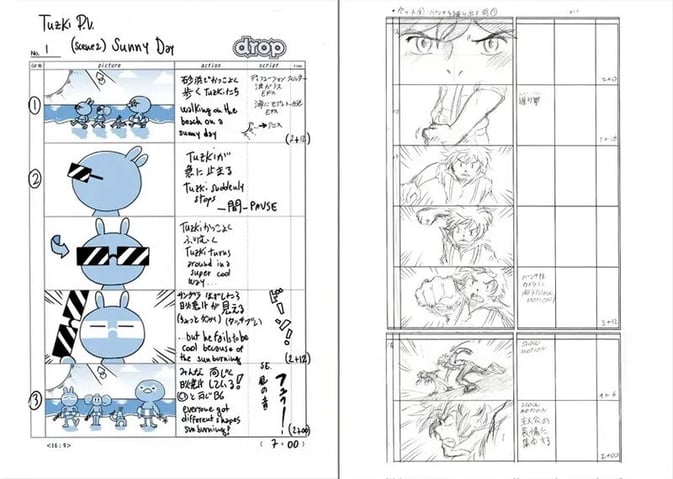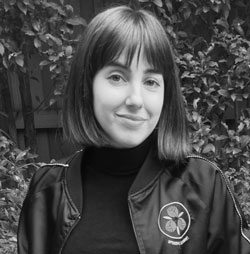All great films, animations, TV series, and even games start with an idea and then a storyboard. Storyboarding has been used in film production since the 1930s, helping to guide the direction and vision of a project, no matter who works on it. In this article, we’ll talk more about storyboarding, why it’s essential in animation projects, how to create an animation storyboard, and how to start your career as a storyboard artist.
What is a storyboard?
A storyboard looks similar to a comic strip. It's a series of pictures illustrating critical moments in the narrative of the animation or film. It’s how artists and directors get a visual sense of how a production will look.
Armed with their storyboards, a director can execute the vision of a production with a clearly defined look and feel. This saves time during filming as everyone knows what to expect with each scene.
Mansour storyboard stills in motion, drawn by CG Spectrum Mentor of the 2D animation courses Alfredo Cassano (Fanar Productions).
Storyboards are created by storyboard artists after the script has been written. A storyboard outlines key features of how an animation or film should be executed and what it should look like when it’s finished. It includes:
- Shot, scene, or sequence numbers/codes (to ensure the order of action is correct)
- Dialog notes or speech bubbles (for key moments in the script)
- Action notes (for character, scene, or prop movement)
- Camera notes (camera angles, movements, and perspectives)
- Visual effects notes
- Any other notes needed to solidify the vision for the narrative

Single animation storyboard tile from Mansour by Alfredo Cassano, demonstrating dialogue, action notes, camera notes, and shot number. (Fanar Productions)
Why do you need a storyboard in animation?
Without a storyboard, a director has no clearly defined frame of reference for each scene. They would have to shoot or animate their project based only on a written script which is much more open to varying interpretations. In films, this means a director might need to shoot multiple takes of each scene, and in animations, they would ask animators for numerous versions of a shot/scene before they were satisfied—both of which are time intensive and confusing for the film crew, animators, and actors.
Here are the top benefits of using a storyboard for animation projects:
- It clarifies the vision: A script can be interpreted in many ways. Until it is storyboarded, the vision for the look and feel of an animation is inside the creator’s head. A storyboard is the first real-life visual representation of a film and allows everyone to share the same vision.
- Helps plan a production: A storyboard can help different production members. For example, a storyboard will share a vision for costuming, props, sets, camera angles, sound, effects, and colorization of the animation or film.
- Acts like a checklist: A good storyboard can act like a checklist for what actors, props, and camera angles are needed for each scene.
- Helps identify production challenges: When a director views the storyboards, they may notice inconsistencies in the narrative or VFX challenges that must be addressed before filming or animation begins.
- Gets projects green-lit: storyboarding helps with securing funding and getting projects green-lit because it allows people investing in the film (producers, studios, etc.) to see more clearly what the project is about and what it will look like.

How to make an animation storyboard
Before a storyboard can be created, the script needs to be completed. Ideally, it should be as near to final as possible so the storyboard can represent the narrative with precise detail.
Here are the steps to make an animation storyboard:
- Get a storyboard template: You'll create your storyboard using thumbnails, usually with 4-6 per page. Your template can be on paper or digitally.
- Create rough sketches: Many animators like to start by drawing rough sketches of each scene before they put the work into captioning and detailing them.
- Add detail and color: The storyboard animator will add details and color. It’s an opportunity to notice any mistakes before the final drawings are created.
- Import into your computer: Add speech bubbles, caption, and layer any additional detail needed. If your sketches were done by hand, you’d scan them into the computer first, then add your annotations. You’ll likely use Adobe Photoshop, Illustrator, or Toon Boom for this step.
- Export to final format: As we saw in the above Mansour example, the storyboard gets turned into a simple animation video sequence. You can also export them as a series of still images.
An example of storyboarding in Pixar’s Up, using a side-by-side comparison with the final animation.
How to become a storyboard artist for animations
Good storyboard artists have a firm grasp of storytelling techniques and how to convey other people's ideas. You’re playing a key conceptual role in an animation or film, so your drawings must convey critical elements of mood, tone, motion, and story progression.
To boost your skills and help prepare you for a career as a storyboard artist, enrolling in an animation course can be a great way to start. Learning the tools and techniques used in animation will not only provide you with some practical transferrable skills (including understanding the 12 Principles of Animation, particularly staging, timing, and solid drawing), but you will also get to experience an animation storyboard from the receiving end which will help to strengthen your communication and visualization skills. You can then apply your animation knowledge to your storyboarding career!
As a storyboard artist for animation or film, you may be asked to:
- Liaise with story and creative team members
- Read scripts
- Break down scripts into scenes
- Sequence scenes into panels of images
- Include special effects notes
- Identify lighting details
- Include critical dialog in story bubbles
- Brief animators or directors on the storyboard
- Revise storyboards throughout the pre-production and production process.
 Two separate examples of animation storyboard art by former CGS animation mentor Misu Yamenko. Misu is Art Director and Storyboard Artist at Alunite, Inc. in Tokyo.
Two separate examples of animation storyboard art by former CGS animation mentor Misu Yamenko. Misu is Art Director and Storyboard Artist at Alunite, Inc. in Tokyo.
Learn more about the animation process at CG Spectrum!
Grow and hone your skills as an animation artist by taking 2D animation or 3D animation courses from CG Spectrum. We’ve trained digital artists who have gone on to work at top studios like Disney, Ubisoft, Industrial Light & Magic, Sony, EA Games, and Wētā FX. You’ll get a personalized educational experience with an industry mentor as your guide.
The next intake is starting soon!

Related Links




